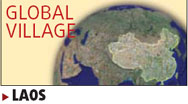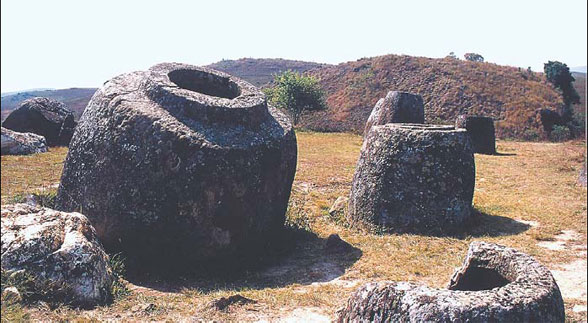Land of mysterious stone jars
|
The Plain of Jars is a large group of historic cultural sites in Laos containing thousands of stone jars, whose origin and function remain unknown to this day. File photo |
Like a young child looking up to an older sibling, the Lao People's Democratic Republic, better known as Laos, sits at China's southern border basking in the influence of its northern neighbor.
Laos, like China, is one of the few modern nations to have successfully molded a communist government to meet the ways of today's world.
Using methods similar to China's, Laos has adapted by decentralizing its economic system, allowing fewer government restrictions on its business.
Unlike China, however, the small country has yet to find its economic groove.
Since less than 10 percent of the country's mountainous landmass is arable, Laos has been unable to form a solid export industry outside the realm of tourism.
What little cash flow Laos maintains comes primarily from trade, aid, and investment by the richer, more powerful nations surrounding it.
In the past, Laos drew a less than innocent crowd as part of the heroin producing region of Southeastern Asia known as "The Golden Triangle".

Laos has since smoked out its drug producing population and sent the economy to rehab. The pipe wielding opium smokers that once flocked to the Laos leg of the golden triangle have long since been replaced by camera wielding tourists looking to cash in on the country's tropical setting.
One of the most intriguing cultural sites of Laos is the Plain of Jars.
An air of mystery hangs around the thousands of stone jars preserved in over 400 cultural sites surrounding the Xieng Khouang plain. The huge earthen jars are said to have been used 1,500 to 2,000 years ago by an obscure Mon-Khmer culture. To this day historians are still speculating about what the jars were actually used for.
The most popular theory speculates that they were once used as urns to house the remains of the cremated.
Thorough research on the jars has been hindered by the unexploded bombs that litter the region. The bombs, a byproduct of Laos's tumultuous past, have rendered all but three or four of the jar sites inaccessible to tourists.
With an estimated 6.2 million people, the entire country of Laos has less than half the population of Beijing. The majority of the population lives outside the capital city of Vientiane. Many live in poverty with no electricity.
As a way of encouraging development, Laos recently fronted a fortune in construction of a hydroelectric dam that will utilize a stretch of the Mekong River that flows through the central provinces of Khammuane and Bolikhamzy.

The $1.5 billion invested by Laos will provide them with enough excess power to sell to their more developed neighbors.
Theravada Buddhism has played a strong role in developing the country's culture. Much of the language, art, and theater are based on traditions rooted in Theravada.
The Khene is a bamboo instrument that produced one of the defining sounds of Laotian music. Mor Lam Sing, which is usually sung to the accompaniment of fiddles, is a more modern form of the sound, and has become a widely popular type of ethnic Lao music. The Mor Lam Sing combines electronic instruments with classic Lao styles to create a modern sound.
Todd Balazovic
(China Daily 06/06/2008 page19)















